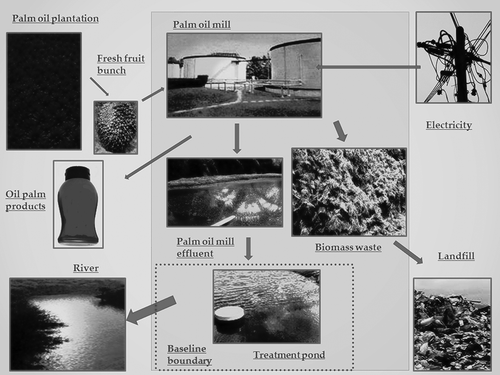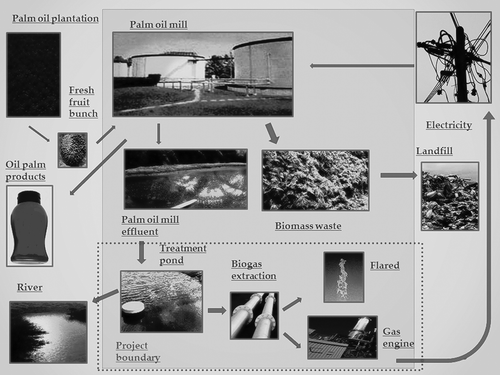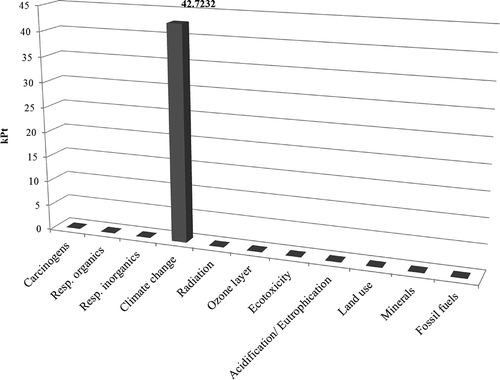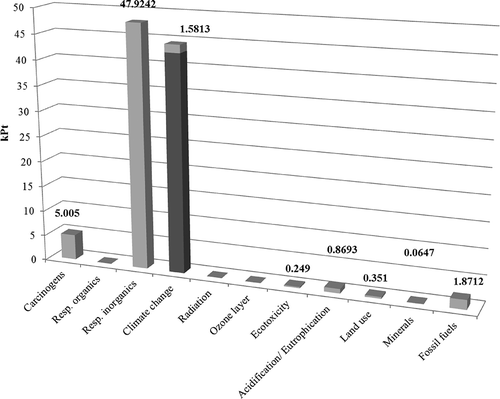Abstract
This study performed an assessment on the beneficial of the Clean Development Mechanism (CDM) application on waste treatment system in a local palm oil industry in Malaysia. Life cycle assessment (LCA) was conducted to assess the environmental impacts of the greenhouse gas (GHG) reduction from the CDM application. Calculations on the emission reduction used the methodology based on AM002 (Avoided Wastewater and On-site Energy Use Emissions in the Industrial Sector) Version 4 published by United Nations Framework Convention on Climate Change (UNFCC). The results from the studies showed that the introduction of CDM in the palm oil mill through conversion of the captured biogas from palm oil mill effluent (POME) treatment into power generation were able to reduce approximate 0.12 tonnes CO2 equivalent concentration (tCO2e) emission and 30 kW·hr power generation per 1 tonne of fresh fruit bunch processed. Thus, the application of CDM methodology on palm oil mill wastewater treatment was able to reduce up to 1/4 of the overall environment impact generated in palm oil mill.
The Clean Development Mechanism (CDM) is an arrangement under the Article 12 of the Kyoto Protocol Kyoto Protocol to support developing countries in greenhouse gas (GHG) reduction. Since CDM indicators only focus on GHG emissions reduction, the life cycle assessment (LCA) methodology could be used to provide additional assessment on the environmental impact of the CDM implementation. This study utilized the GHG emission reduction indicators obtained from CDM methodology for calculating the environmental impacts based on various environmental consequences and evaluation.
Introduction
On December 11, 1997, an international agreement linked to the United Nations Framework Convention on Climate Change (UNFCCC) was formed under the name of Kyoto Protocol (CitationFletcher, 2004). The main purpose of the Kyoto Protocol is to commit Annex I industrialized countries and the European community to comply to a legally binding agreement for reducing six main greenhouse gas (GHG) emissions such as carbon dioxide (CO2), methane (CH4), nitrous oxide (N2O), sulfur hexafluoride (SF4), hydrofluorocarbons (HFCs), and perfluorocarbons (PFCs) (CitationFletcher, 2004). The Clean Development Mechanism (CDM) defined under Article 12 of the Kyoto Protocol allows developed countries to meet their emission reduction commitments through the transfer of clean technology, carbon finance, and capacity development for assisting developing countries to achieve sustainable development through the stabilization of greenhouse gas concentrations in the atmosphere (Bellona CitationFoundation, 2007).
As a developing country, Malaysia is not bound by any commitment to reduce greenhouse gas emission, but by participating in the CDM, Malaysia could benefit from the monetary investment of the projects. On 12th March 1999, Malaysia became a signatory to the Kyoto Protocol and announced the country's ratification of the Protocol on 4th September 2002 during the World Summit on Sustainable Development. Being a signatory to the Protocol, Malaysia is committed to the full implementation of CDM in an equitable manner (CitationYahaya, 2005). Initially, CDM was introduced in Malaysia through the Energy Policy & 8th Malaysia Plan, with the main focus on energy (CitationLim et al., 2006). However, in recent years the involvement of palm oil industry in CDM project have increase gradually. Carbon credits or Certified Emission Reduction (CER) revenues from CDM project in the palm oil industries contributed the most CER revenues in the country with 33% of the total at year 2010 (GreenTech Malaysia, 2006). CDM practice has thus proven to be financially beneficial for the palm oil industry (CitationJensen, 2004).
Malaysia is the second largest palm oil production country after Indonesia, producing around 18 million tonne in year 2009 (CitationUSDA, 2010a). Since year 2005, palm oil overtook soybean oil as the world most productive edible vegetable oil crop, with annual production in year 2009 at 45 million tonne, which accounted for almost 32% of global production (CitationUSDA, 2010b; CitationWorld Growth, 2009). As of 2009, the cumulative land area of palm oil plantations in Malaysia reached 4.69 million hectares (CitationUSDA, 2010b). The Malaysian palm oil industry is responsible for around 40% of the world's production, and it is estimated that in year 2009, it managed to produce 15 million tonne of export, with the earnings worth RM 49.6 billion through oil palm product, whilst creating more than half a million employment directly and indirectly (CitationMPOB, 2010; CitationMPOB and APOC, 2010).
Effluent treatment of palm oil mill's process is one of the most significant contributors to global warming through GHG emission (CitationSchmidt, 2010). With the introduction of digester tanks, the utilization of the captured biogas will generally reduce the palm oil industry contribution to global warming potential (CitationSchmidt, 2010). The CERs from the CDM application provide an additional incentive for the palm oil industry to invest with new technology on palm oil treatment incorporating biogas utilization system.
Since CDM indicators only focus on GHG emissions reduction, the life cycle assessment (LCA) methodology could be used to provide additional assessment on the environmental impact of the biogas captured. Hence, LCA could be used as a possible tool for assessing the environmental impacts associated with the achievement of emission reduction through CDM implementation. The LCA methodology and standards can be used to complement the CDM evaluation. Every CDM project cycle requires an initial and on-going identification of project GHG emissions. Thus the LCA standards of International Organization for Standardization (ISO) 14040 offer a comprehensive methodology for performing GHG inventory identification and GHG reduction opportunities (CitationISO, 2006). LCAs are able to evaluate the environmental consequences of product or processes through “cradle-to-grave” approach (CitationYusoff, 2004).
Objectives
The objective of this research is to study the benefits of the CDM implementation towards sustainable development using the perspective of life cycle assessment. This study will utilize the GHG emission reduction indicators obtained from CDM methodology for calculating the environmental impacts based on various environmental consequences and evaluation, such as carcinogenic effect, damages to respiratory system, climate change, radiation, ozone layer, ecotoxicity, land use, mineral depletion, and fossil fuel depletion. The Eco-indicators 99 assessment method in SimaPro LCA software (PRé Consultants, the Netherlands) will be used in the study.
Methodology
Site visit to a selected Palm Oil Mill located at Perak, Malaysia, was carried out for the purpose of this study. The palm oil mill implemented CDM project with an activity involving capturing of biogas through continuous-flow Closed-Tank Stirred Reactor (CSTR) installation of anaerobic treatment for palm oil mill effluent (POME). The open digesting tank and anaerobic lagoons are one of the common practice used for POME treatment; however, CDM application gave the mill an extra incentive to financially invest in closed-tank anaerobic digester system with biogas capture technology (CitationLatif et al., 2003; CitationShirai et al., 2003; CitationYeoh, 2004). CitationYacob et al. (2005) also revealed that for POME treatment, anaerobic pond system is more efficient in terms of high chemical oxygen demand (COD) removal efficiency with lower solid discharge, shorter hydraulic retention times, and higher methane yield and extraction compared with open digesting tank system. This method of waste treatment also meets the effluent discharge standards stipulated by the Department of Environment, Malaysia, under the Environmental Quality Act (EQA), 1974 (Act 127) (CitationCDM, 2008). Methane captured through these processes will be utilized for on-site electricity generation and steam generation whereas the excess will be flared.
The palm oil mill is equipped with a processing capacity of 80 tonne per hour FFB (fresh fruit bunches) on average. Almost 525 thousand tonne of FFB per year was expected to be processed by the mill during the crediting period, with almost 315 thousand m3 of wastewater generated per year.
Based on the 3 months monitoring from September to November in 2009, the average COD for POME intake was 66.1 thousand ppm. Under the baseline scenario, treatment of POME through the anaerobic ponding system is estimated to be capable of reducing up to 95% of COD level. The main concern of greenhouse gas emissions in the baseline scenario is methane gas from the open anaerobic ponds. The biogas was captured through the anaerobic treatment of POME. The captured biogas will be utilized for on-site power generation with steam turbine and two 0.5-megawatt gas engines. The power generation was not exported to the national electricity grid due to the high cost of connecting to the grid, especially for a small-scale project.
and show the baseline boundary and project boundary of the CDM project. The palm oil mill monitored the amount of biogas produced through POME treatment for the period of 3 months starting from September to November in 2009 and the data collected are shown in These data will be used for the calculation of emission reduction which will be based on the approved methodology of AM002: Avoided Wastewater and On-site Energy Use Emissions in the Industrial Sector (Version 4), published by United Nations Framework Convention on Climate Change (CitationUNFCCC 2006) (CitationUNFCCC, 2006). This methodology has been widely used by project developers to register their project and for claiming CERs.
Table 1. Monitoring of biogas data from the palm oil mill
The emission reduction data were then assessed for impact assessment analysis using the standard LCA software. The total amount of emission reduction in the value of tonnes CO2 equivalent concentration (tCO2e) and total amount of electricity generation in kilowatt hour (kW·hr) through this CDM application was recorded for LCA analysis in SimaPro software using Eco-indicator 99 damage-oriented impact assessment method. The selected Eco-indicator 99 method provides measurement on various environmental impacts and damages, such as carcinogenic effect, damages to respiratory system, climate change, radiation, ozone layer, ecotoxicity, land use, minerals depletion, and fossil fuel depletion (CitationGoedkoop and Spriensma, 2001). The Eco-indicator 99 assessment will normalize the final result to constitute a single score point called Eco-indicator point (Pt). This Eco-indicator point (Pt) represents the fraction of annual environmental loads per thousand capita against total environmental impact in the country (CitationGoedkoop and Spriensma, 2001).
Results
The emission reduction for the total of 3 months from September 2009 to November 2009 was calculated using the CDM methodology AM002. The following calculations are as shown (Equation1–15 from (CitationUNFCCC, 2006)):
The emission reductions can be expressed as
where EBL is total baseline emissions and EPA is the total project emissions.
ECH4anaerobic is the amount of fugitive methane emissions from anaerobic system. ECH4lagoon is the amount of fugitive methane emissions from lagoon after closed digester tanks. The amount is equal to zero by assuming that there are no changes in methane emission between each pond. ECH4NAWTF is the amount of fugitive methane emissions from closed anaerobic digester tanks and is equal to zero with the assumption that there is no leakage of methane gas. ECH4IC is the amount of methane emissions from inefficient combustion, calculated using Equationeq 5(5) and equals 9441 tCO2e, whereas LEAK is equal to zero with the assumption that there is no leakage of methane in the system. Thus, from Equationeq 3
(3) EPA will be directly equal to ECH4IC.
Mlagoon is the mass of methane emissions from the lagoons at 4503 tonnes COD (tCOD) calculated using Equationeq 6.(6) EFCH4 is the methane emission factor, with the default value of 0.21, and GWPCH4 is the global warming potential of methane, with the default value of 21 (CitationUNFCCC, 2006). The volume of biogas sent to the combustion process (ΣVr) is 414,156 m3, taken from the monitoring data of CCH4 is the concentration of methane in biogas at 0.00044 t/Nm3 calculated using Equationeq 7
(7). The proportion of biogas destroyed by combustion (fr) is calculated using Equationeq 8
(8) at 93.095%. PEflare is the total amount of biogas sent for flaring, calculated using Equationeq 9
(9) at 9175 tCO2e.
Mlagoon_total is the mass of organic material removed in anaerobic lagoon, calculated using Equationeq 9(9) at 4867 tCOD. Mlagoon_aerobic is the mass of organic material degraded aerobically and calculated using Equationeq 11
(11) at 89.91 tCOD. Mlagoon_chemical is the mass of organic material lost through oxidation at 31.11 tCOD calculated using Equationeq 12
(12). Mlagoon_deposition is the mass of organic material deposited in lagoon, calculated using Equationeq 13
(13) at 243 tCOD. Mass of methane in the biogas (MCH4) is calculated using Equationeq 14
(14) at 1110 tonne. VCH4 is the volume of methane in biogas at the amount of 2,510,771 Nm3, taken from NCVCH4 is the net calorific value of methane, with the default value of 50.4 GJ/kg (CitationUNFCCC, 2006). EFCH4_SC is the default methane emission factor from stationery combustion at 1.37 kg/TJ (CitationUNFCCC, 2006). Volume of biogas sent to flaring (ΣVrflaring) is 1,975,115 m3, taken from , and the default value of flare combustion efficiency for open flaring (ηflare) is 0.5 (CitationUNFCCC, 2006).
Mlagoon_input is the mass of organic material input into the lagoon and calculated using Equationeq 15(15) at 5178 tCOD. Rlagoon is the removal ratio of organic material in the lagoon with the default value of 0.94 (CitationUNFCCC, 2006). The area of the lagoon is 3.89 ha, whereas the monitoring period was 91 days, and the surface loss is at 0.254 tCOD/ha/day (CitationUNFCCC, 2006). QPOMEinlet is the POME input quantity at 78,337 m3 from Sulfate concentration is 0.61 kg/m3 from COD loss per oxidant is 0.651 kgCOD/kg Ox by default (CitationUNFCCC, 2006). Rdeposition is the factor of deposition in the lagoon with the default value at 5% (CitationUNFCCC, 2006). PCH4 is the percentage of methane in the biogas at 61.79% from and ρCH4 is the density of methane at 0.716 kg/Nm3 (CitationUNFCCC, 2006).
where COD of POME input (CODponds_inlet) is 54.97 kg/m3.
From Equationeq 3(3), the EPA is 9441 tCO2e, whereas from Equationeq 2
(2) EBL is equal to ECH4anaerobic and ECH4anaerobic is equal to 19,858 tCO2e using Equationeq 4
(4). Thus, the total reduction achieved on the greenhouse gas emission is10,417 tCO2e, calculated using Equationeq 1
(1).
By applying LCA analysis on the achieved emission reduction of 10,417 tCO2e, the result generated through SimaPro software using “Eco-indicator 99 (H) v2.07/Europe EI 99 H/H Weighting” methodology showed that emission reduction within 3 months succeeded in reducing 42.72 kPt of damages to the environment, as shown in
Discussion
The effort incorporating the capturing of methane from the POME treatment helps in reducing GHG emission into the atmosphere and whilst also generating additional electricity supply through the utilization of methane gas by the biogas engine. This generation helps the mill to decrease electricity usage and, importantly, indirectly reducing the carbon footprint of the mill's operation. Thus, it is beneficial that power generation aspect should also being considered for LCA analysis.
By considering the 754,292 kilowatt hour (kW·hr) of power saving through the biogas engine installed, the LCA analysis showed a favorable result on emission reduction of almost 10,417 tCO2e and 754,292 kW·hr of power saving, as shown in shows that the implementation of CDM can save a total score of 100.6 kPt in damages to the environment. However, not all the captured biogas could be utilized within the mill. Hence the excess biogas was flared, as the high cost of grid connection remains a deterrent exacerbated by a small economy of scale (CitationIPCC, 2000).
This study also investigated how much will the CDM implementation be more useful if assumption that all biogas be reverted into the biogas power plant without being flared. Referring to Equationeq 16(16) (CitationCDM, 2008), the project emission will be reduced to as low as 266 tCO2e when PEflare is equal to zero.
Consequently, this shows that emission reduction will increase to almost 98% of the baseline emission and achieves 19,593 tCO2e of reduction, whereas the amount of power generated by biogas engine is expected to reach 4 million kW·hr with the biogas engine efficiency at 1.6 kW·h of energy generated per volume (m3) of methane supplied. As a result, CDM in converting methane gas from POME treatment into power generation is capable of achieving approximate 0.14 tCO2e emission of reduction and 30 kW·h power generations per 1 tonne of fresh fruit bunch processed
In , the LCA analysis showed the results of emission reduction of 19,539 tCO2e and power saving of 4 million kWh. The results showed that the processing of 136 ktonne fresh fruit bunch (FFB) generated 387,000 of Eco-indicator point (Pt). One Eco-indicator points is equivalent to 1/1000 of the annual environmental load per capita. Thus, 387 kPt are equivalent to 38700% of the environmental impacts produced by a single person annually.
Figure 5. LCA result on achieved emission reduction and power saving if all biogas converted into power generation.
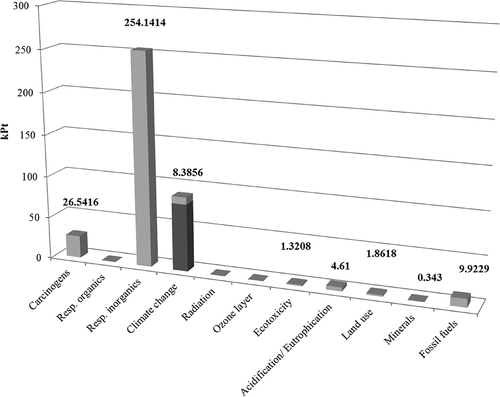
In Malaysia, with yearly production of FFB at 90 million tonne in 2009 (CitationUSDA, 2010b), and 28.3 million population at year 2009 (CitationIPCC, 2000), the calculated emission reduction through the CDM will be able to save 0.9% of the total environmental impacts in Malaysia. By referring to the earlier research by CitationYusoff and Hansen (2007), crude palm oil production is responsible for approximate 3.5% of yearly environmental impacts in Malaysia, thus indicating that the implementation of CDM for treatment on POME will help in reducing almost 25% of total impacts generated by palm oil industry.
Conclusion
Vegetable oils had emerged as a potential replacement for depleting fossil fuels in the market, especially with its potential as biodiesel. This renewable biofuel is one of the main agenda discussed in CitationEuropean Union directive 2009/28/EC (CitationEuropean Union, 2009). CDM brought a new lifeline to palm oil industry in mitigation GHG emissions and consequently increase the sustainability of oil palm products.
Through this research, it was found that the introduction of CDM into palm oil industry not only helps to improve the treatment of wastewater in the palm oil mill due to technology transfer, but importantly is also able to reduce the total environment impact generated from palm oil industry to at least 25% of overall damages generated. Although this research is based on the results collected from one palm oil mill, which was generous in assisting in data collection, whereas most of other mills approached were not very cooperative in allowing for monitoring of their CDM project. Therefore, the result generated might solely disclose the scenario of a selected mill and it could be improved with the participation of more mills in the future.
References
- Foundation , Bellona . 2007 . The Clean Development Mechanism—CDM. The Bellona Foundation—Fact sheet: CDM , Oslo , , Norway : Bellona International .
- CDM in Malaysia: CDM Potential in Malaysia. http://cdm.eib.org.my/subindex.php?menu=7&submenu=43 (http://cdm.eib.org.my/subindex.php?menu=7&submenu=43) (Accessed: 1 March 2011 ).
- European Union . 2009 . Directive 2009/28/EC of the European Parliament and of the Council , European Union .
- Fletcher , S.R. 2004 . Global Climate Change: The Kyoto Protocol (RL30692) , Washington , DC : Congressional Research Service . Report for The Library of Congress.
- Fry , J. 2010 . Asean: Regional Trends in Economic Integration, Export Competitiveness, and Inbound Investment for Selected Industries , Washington , DC : United States International Trade Commission .
- Goedkoop , M. and Spriensma , R. 2001 . The Ecoindicator_99: A Damage Oriented Method for Life Cycle Impact Assessment: Methodology Annex , Amersfoort , The Netherlands : Pré Consultants .
- GreenTech Malaysia. 2006. CDM Potential in Malaysia. Environmental Management & Climate Change Division, Ministry of Natural Resources and Environment. http://cdm.greentechmalaysia.my/cdm-malaysia/potential.aspy (http://cdm.greentechmalaysia.my/cdm-malaysia/potential.aspy) (Accessed: 14 March 2009 ).
- ISO (International Organization for Standardization) . 2006 . ISO 14040—Environmental Management. Life Cycle Assessment. Principles and Framework , Geneva : ISO .
- Jensen , H.R. 2004 . Current Issues in CDM and Projects in Malaysia Ho Chi Minh , , Vietnam Paper presented at the CDM seminar by COGEN
- Latif , A.A. , Suzylawati , I. , Norliza , I. and Subhash , B. 2003 . Removal of suspended solids and residual oil from palm oil mill effluent . Journal of Chemical Technology and Biotechnology , 78 : 971 – 978 .
- Lim , C.H. , Salleh , E. and Jones , P. 2006 . Renewable energy policy and initiatives in Malaysia . International Journal on Sustainable Tropical Design Research and Practice , 1 : 33 – 40 .
- Metz , B. , Davidson , O. , Martens , J.-W. , Rooijen , S.V. and McGrory , L.V.W. 2000 . Methodological and Technological Issues in Technology Transfer , Cambridge , England : Cambridge University Press .
- Schmidt , J.H. 2010 . Comparative life cycle assessment of rapeseed oil and palm oil . International Journal of Life Cycle Assessment , 15 : 183 – 197 .
- Shirai , Y. , Wakisaka , M. , Yacob , S. , Hassan , M.A. and Suzuki , S. 2003 . Reduction of methane released from palm oil mill lagoon in Malaysia and its countermeasures . Mitigation and Adaptation Strategies Global Change , 8 : 237 – 252 .
- US Department of State. 2009. Background Note: Malaysia [online] (updated July 14, 2010). http://www.state.gov/r/pa/ei/bgn/2777.htm (http://www.state.gov/r/pa/ei/bgn/2777.htm) (Accessed: 1 October 2010 ).
- UNFCCC (United Nations Framework Convention on Climate Change) . 2006 . AM0022: Avoided Wastewater and On-site Energy Use Emissions in the Industrial Sector , Bonn , , Germany : UNFCCC . Version 04, December 2006.
- USDA (United States Department of Agriculture). 2010a. Palm Oil: World Supply and Distribution. http://www.fas.usda.gov/psdonline/psdreport.aspx?hidReportRetrievalName=BVS&hidReportRetrievalID=710&hidReport RetrievalTemplateID=8 (http://www.fas.usda.gov/psdonline/psdreport.aspx?hidReportRetrievalName=BVS&hidReportRetrievalID=710&hidReport RetrievalTemplateID=8) (Accessed: 19 September 2010 ).
- USDA (United States Department of Agriculture). 2010b. Major Vegetable Oils: World Supply and Distribution (commodity view). http://www.fas.usda.gov/ psdonline/psdreport.aspx?hidReportRetrievalName=BVS&hidReportRetrieval ID=702&hidReportRetrievalTemplateID=5 (http://www.fas.usda.gov/ psdonline/psdreport.aspx?hidReportRetrievalName=BVS&hidReportRetrieval ID=702&hidReportRetrievalTemplateID=5) (Accessed: 20 September 2010 ).
- Wahid , M.B. 2010 . Overview of the Malaysian Oil Palm Industry 2009 , Kuala Lumpur : Malaysian Palm Oil Board .
- World Growth . 2009 . Palm Oil—The Sustainable Oil A Report by World Growth. September 2009
- Yacob , S. , Hassan , M.A. , Shirai , Y. , Wakisaka , M. and Subash , S. 2005 . Baseline study of methane emission from anaerobic ponds of palm oil mill effluent treatment . Science of the Total Environment , 366 : 187 – 196 .
- Yahaya , N. 2005 . “ CDM in Malaysia: Policies and Rules ” . In The Clean Development Mechanism (CDM) Seminar in Malaysia , Putrajaya , , Malaysia : Ministry of Science, Technology and the Environment . Kuala Lumpur, Malaysia, 10 March 2005
- Yee , N.T. 2008 . Methane Capture and On-site Power Generation Project at Syarikat Cahaya Muda Perak (Oil Mill) Sdn. Bhd. in Tapah, Perak, Malaysia Clean Development Mechanism Project Design Document Form - Version 03.1. United Nations Framework Convention on Climate Change.
- Yeoh , B.G. 2004 . A technical and economic analysis of heat and power generation from biomethanation of palm oil mill effluent . Electricity Supply Industry in Transition: Issues and Prospect for Asia , 20 : 63 – 78 .
- Yusoff , S. 2004 . Life cycle assessment—a tool for environmental management . SIRIM Stand Quality News , 11
- Yusoff , S. and Hansen , S.B. 2007 . Feasibility study of performing an life cycle assessment on crude palm oil production in Malaysia . International Journal of Life Cycle Assessment , 12 : 50 – 58 .
